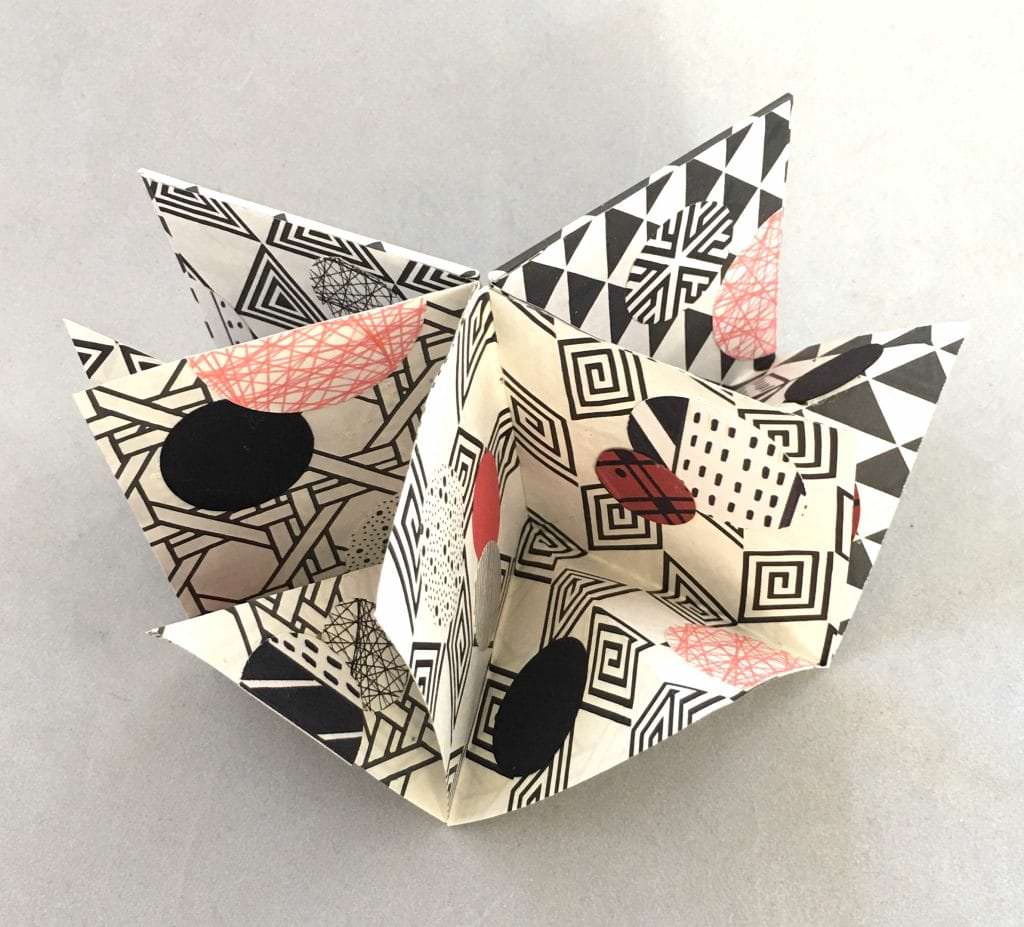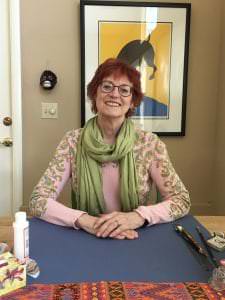
Paper Connection was thrilled to catch up with true paper lover, Kit Davey from Found • Object • Art
Circuitous and Non-linear
Kit loves paper and saves every scrap. “I am constantly thinking about making books. I usually get the germ of an idea while walking, or by being inspired by other artists on Instagram or Pinterest. I jot down or sketch the idea, put it in a clear plastic sleeve and then add it to my project box. When I find papers, ephemera or other bits the might work with the idea, I slip them into the sleeve. I work in my studio every day and I make about a book a day. I look through my project box and pick out the idea that calls me. Each book unfolds through trial and error. Selecting the perfect paper is crucial. I use my “gut-o-meter” to tell me when something works or not.”
Q+A
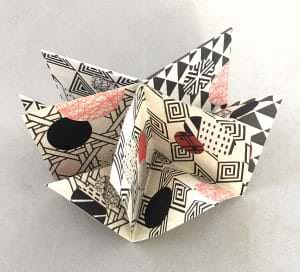
PCI: Kit, talk about your interests and why this is your form of expression as opposed to a straight up “printer-ly” technique?
KD: What I love about paper/collage in my bookmaking is the spontaneity, making changes as I go along. I don’t need special aptitudes, other than the ability to combine. I have choices of dozens of bindings, most of which don’t require skill with a needle and thread. I sometimes print out words or a story, digitally, because my handwriting is bad. I do admire the books made by printers, but don’t like the process for my own work. Printing a book requires planning which interrupts my spontaneity.
PCI: How have your life experiences brought you to create Found • Object • Art ?
KD: When I was a little girl I loved found objects and using them to create something new. I made houses for field mice with shoeboxes, matchboxes and bottle caps. I made books like “Love is…” with paper bits and crayons. I took art classes along the way but felt constrained by two dimensions and needing ‘skills’ like drawing or painting. I started to find my “inner gleam” by experimenting with collage and assemblage on my own. I was introduced to a collage class and began to learn the endless possibilities of working with paper and found images, often making books. One of my classmates suggested I join the Bay Area Book Artists. There, I found my tribe, learning a myriad of book structures and bindings from my fellow bookmakers. I continue to hone my skills by taking classes and learning from others.
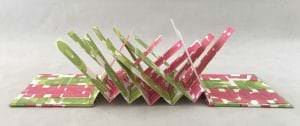
PCI: What happened next and bring us up to the present?
KD: I began selling at art fairs and bookmaking events then started teaching about 15 years ago. I decided to widen my reach by adding Found • Object • Art to share a variety of my work (artist books, matchbox art, greeting cards, etc.) and promote learning opportunities for folks around the world. During this pandemic, I created five live, on-line Zoom classes. Each bookmaking class has a non-standard structure and a no-stitch binding, making it doable for all levels and capabilities. Anyone with curiosity and interest can delve into my classes. I am so impressed by the creativity. Two more classes were requested by my students so number six is up and running with one more in the works. I added Instagram, posting new work almost daily. I receive so much wonderful feedback from my followers (I have over 32,000!). The Instagram community has been so supportive, I attribute a lot of my success to this social network.
PCI: Tell us about your ‘Button Books!’

KD: Several years back I saw a book made with tiny buttons on Pinterest. I jumped out of my chair, immediately searched through my stash of antique buttons for a matching pair. I experimented with different ways of making pages, binding them together and finding content to embellish. Over time I created a foolproof process which I teach.
PCI: Would you share your insights and process regarding projects that have set you on a new path?
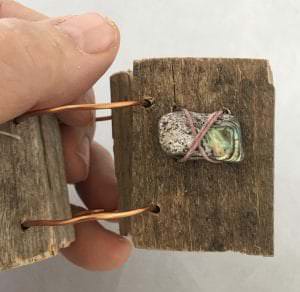
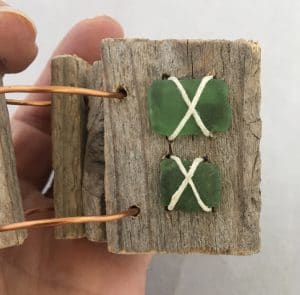
KD: I am continually inspired by things I find on the ground. I know I can use it in a book or art piece! Recently I discovered a weathered wooden stake on the ground in my local park. I cut it into sections to be used as ‘pages.’ Coincidentally, Instagram’s #areyoubookenough monthly challenge was “Sea” and an idea for a book popped into my mind – I could attach sea glass and shells to the pages to create a book. I drilled holes through the wood so I could strap on the found objects. Holes on the edges of the wood allowed me to use copper wire loops as a binding.
PCI: Which artist/people in your life most influenced/inspired you and in what way?
KD: I honestly don’t have any particular influencers or inspirers. Creations by unknown artists and bookmakers have led me to learn processes and to experiment. Trial and error is my greatest teacher. My own “voice” comes forth as I follow my experiments and make choices. I know that by making lots of art I get better and better as an artist.
PCI: Can you describe the importance of paper in your work and what type of paper do you use?
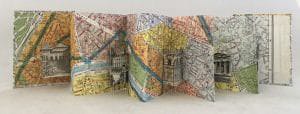
KD: Paper is my foundation. Each page has carefully selected papers culled from my substantial stash of dictionary pages, images from vintage books, music scores, letters, ephemera, card stock, rice papers, scrap booking paper, maps, wrapping paper, craft paper, grocery bags, used envelops, magazine pages, textbooks, tissue papers, printed napkins, calendars, posters. When I finish a book I save all the little pieces in a bag called “Bits.” Even the tiniest piece of paper has potential to become part of my art.
PCI: Are there particular questions no one has asked you with regards to your creative process, philosophy or recent experiences you’d like to share?
KD: Yes. One question is “What is your mission as an artist?” My answer: “To spread delight across the planet.”
PCI: So, If you could have a conversation with any artist present or past, who would it be?
KD: I would have wanted to be a fly on Joseph Cornell’s work room ceiling. I’d love to have seen his work surface, the ingredients of his boxes strewn about, and his many image files. I’d silently cling to the ceiling and watch as he created one of his magical boxes.
PCI: Anything else you like to add?
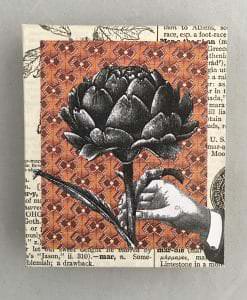
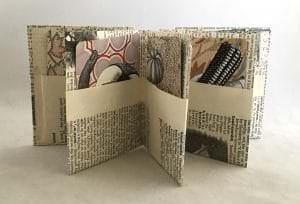 KD: Every piece of paper has potential!
KD: Every piece of paper has potential!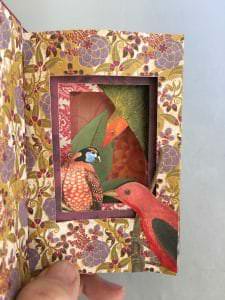
All images thanks to Kit Davey.

